Related Research Articles

The Economic Development Board (EDB) is a statutory board under the Ministry of Trade and Industry of the Government of Singapore that plans and executes strategies to sustain Singapore as a leading global hub for business and investment.
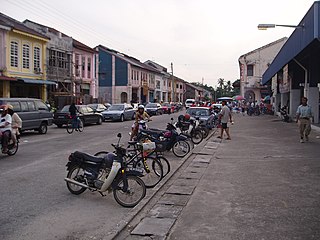
Teronoh is a small tin-mining town in Kinta District, Perak, Malaysia.

Taiping is a town located in Larut, Matang and Selama District, Perak, Malaysia. It is located approximately 48 km (30 mi) northwest of Ipoh, the capital of Perak, and 78 km (48 mi) southeast of George Town, Penang. With a population of 245,182, it is the second largest town in Perak after Ipoh, the state capital.

The term "British Malaya" loosely describes a set of states on the Malay Peninsula and the island of Singapore that were brought under British hegemony or control between the late 18th and the mid-20th century. Unlike the term "British India", which excludes the Indian princely states, British Malaya is often used to refer to the Federated and Unfederated Malay States, which were British protectorates with their own local rulers, as well as the Straits Settlements, which were under the sovereignty and direct rule of the British Crown, after a period of control by the East India Company.

Mining in Cornwall and Devon, in the southwest of England, began in the early Bronze Age, around 2150 BC. Tin, and later copper, were the most commonly extracted metals. Some tin mining continued long after the mining of other metals had become unprofitable, but ended in the late 20th century. In 2021, it was announced that a new mine was extracting battery-grade lithium carbonate, more than 20 years after the closure of the last South Crofty tin mine in Cornwall in 1998.
Kapitan China Chiew Yuen LamMSC, JP ; 28 September 1879 – 1935) was a wealthy Malayan tin miner and rubber planter. Chinese Business in Southeast Asia: Contesting Cultural Explanations by Edmund Terence Gomez, Hsin-Huang Michael Hsiao, Page 169</ref> of Hakka ancestry who was raised on the island of Penang in the state of the same name in Malaysia, known at that time as British Malaya. He pioneered the cultivation of Roselle for the production of Roselle fibre rope and twine, his initial effort including the Sweet Kamiri Estate in Sungei Siput. He was a member of the Perak Advisory Board and the last Kapitan China of Perak and Malaya. At the time of his death he was said to have been the wealthiest man in Penang. There was a big turnout at his funeral in Penang including many prominent personalities from the Federated Malay States and the Straits Settlements and the funeral procession was a quarter of a mile long.
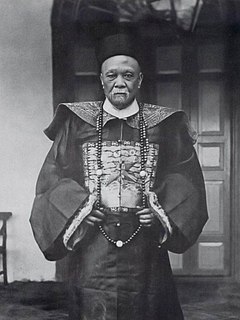
Kapitan China Chung Keng Quee was the founder and administrator of modern Taiping in Perak, Malaysia. Appointed "Capitan China" by the British in 1877, he was a millionaire philanthropist and known as an innovator in the mining of tin. He was involved in many other industries including farming, pawnbroking and logging. He was respected by both Chinese and European communities in the early colonial settlement. His survival in the chaotic era owes much to his standing as leader of the Hai San, a Chinese secret society in British Malaya during the time of the Larut Wars (1862–73). a position he is said to have held till early 1884 although in all probability he continued to remain a leading member. The old fort at Teluk Batu was built by him to safeguard the mine that he opened there. He was a member of the Commission for the Pacification of Larut and sat as one of six members of the Advisory Perak State Council appointed by the British. Commenting on the role of the Perak Council, Richard James Wilkinson wrote,
"It is for the reader, in the light of subsequent events, to judge how far the Councillors were right or wrong, and to see for himself who really did the pioneer work of building up the prosperity of Perak. In the published accounts of British rule in Malaya, sufficient prominence has not always been given to the efforts of these early pioneers; the reaper, intent on his own work, is apt to forget the man who sowed. These Council Minutes are the record of the work of the sowers. A study of that record will show how much the State owes to Sir Hugh Low and to his fellow-Councillors, especially Raja Dris, Sir William Maxwell, and the Chinese towkays, Ah Kwi [Chung Keng Quee] and Ah Yam."
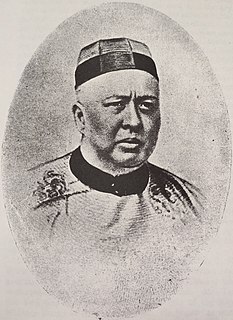
Tan Kim Ching, also known as Tan Kim Cheng, was a Chinese politician and businessman. He was the eldest of the three sons of Tan Tock Seng, the founder and financier of Tan Tock Seng Hospital. He was consul for Japan, Thailand and Russia, and was a member of the Royal Court of Siam. He was one of Singapore's leading Chinese merchants and was one of its richest men in Singapore at that time. He was also the first Asian member of the Straits Branch of the Royal Asiatic Society. After his father's death, he became the Kapitan Cina of the Straits Chinese community. He is believed to have been the head of the Triad in Malaya.

Eu Tong Sen was a leading businessman in Malaya, Singapore and Hong Kong during the late 19th and early 20th century. He was vice-president of the Anti-Opium Society and a member of the Kinta Sanitary Board.
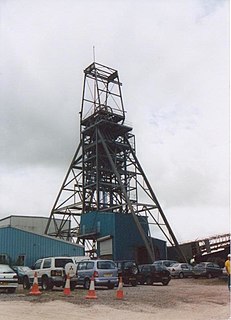
South Crofty is a metalliferous tin and copper mine located in the village of Pool, Cornwall, United Kingdom. An ancient mine, it has seen production for over 400 years, and extends almost two and a half miles across and 3,000 feet (910 m) down and has mined over 40 lodes. Evidence of mining activity in South Crofty has been dated back to 1592, with full-scale mining beginning in the mid-17th century. The mine went into serious decline after 1985 and eventually closed in 1998. After several changes of ownership, South Crofty is owned by Cornish Metals Inc, which is working to re-open the mine, as of November 2022, having receive a permit for dewatering the mine.
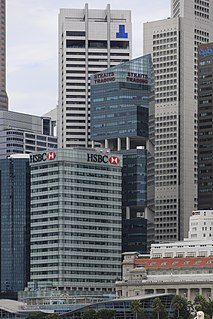
The Straits Trading Company Limited is a Singapore-based corporation with operations in Singapore and Malaysia, as well as various localities in Asia and Australia.

The Hai San Society, which had its origins in Southern China, was a Penang-based Chinese secret society established around 1820 and in 1825 led by Low, Ah Chong and Hoh Akow, its titular head. At that time the society's headquarters was located at Beach Street.
John Buttery was a merchant operating in the Straits Settlements of Penang, Malacca and Singapore. He was, at the time of his death, the senior partner of Sandilands, Buttery & Co., and John Buttery & Co..
Foo Choo Choon, a Hakka tin miner, revenue farmer and businessman from Penang and Perak was, in his time, said to have been the richest Chinaman in the world.
Wee Bin born in China in 1823, was a Chinese migrant of the mid-nineteenth century who founded what was, at the time, Singapore's largest Chinese shipping firm.
Leong Sin Nam 梁燊南, alias Leong Sin, Leung Sin, Leong Sin Hee, was a Malaysian businessman. He migrated and settled in British Malaya in 1898. From humble beginnings, he worked hard to become a wealthy tin mine owner in Perak. He was a businessman, an active community leader and a philanthropist. He was a Chinese revolutionary with similar aspirations as Dr. Sun Yat Sen and a strong supporter of the Chinese war efforts during the Sino-Japanese war.
The Rubber Trade Association of Penang (槟城树胶公会), one of the oldest surviving rubber trade associations in the country, represents the interests of members of the rubber trade in the state. It is also known as the Penang Rubber Trade Association.

Toh Aik Choon was born in the Malayan seaport of Penang in 1927. He was the youngest child in a family of three. A.C. attended the Chung Ling High School in Penang before his education was disrupted by the Second World War.

Since its formation in 1963, Malaysia's economic performance has been one of Asia's best. Real gross domestic product (GDP) grew by an average of 6.5% per year from 1957 to 2005. Performance peaked in the early 1980s through the mid-1990s, as the economy experienced sustained rapid growth averaging almost 8% annually. High levels of foreign and domestic private investment played a significant role as the economy diversified and modernised. Once heavily dependent on primary products such as rubber and tin, Malaysia today is an upper middle-income country with a multi-sector economy based on services and manufacturing. Malaysia is one of the world's largest exporters of semiconductor components and devices, electrical goods, solar panels, and information and communication technology (ICT) products.
This article lists important figures and events in the public affairs of British Malaya during the year 1925, together with births and deaths of prominent Malayans.
References
- ↑ Memoir By Malaya Geological Survey Dept, Published by Government Press 1960s p. 279
- ↑ The Mining Magazine: For Minerals Industry Management Worldwide By Published by Mining Publications, 1909 p. 33
- ↑ Statistical Year Book of the International Tin Research and Development Council By Statistical Office, International Tin Research and Development Council, International Tin Research and Development Council Published by International Tin Research and Development Council, 1937, p. 41, 206
- ↑ Straits Tin; a Brief Account of the First Seventy-five Years of the Straits Trading Company, Limited. 1887-1962.: A Brief Account of the First Seventy-five Years of the Straits Trading Company, Limited, 1887-1962 By K G Tregonning Published by Straits Times Press, 1962; p. 46